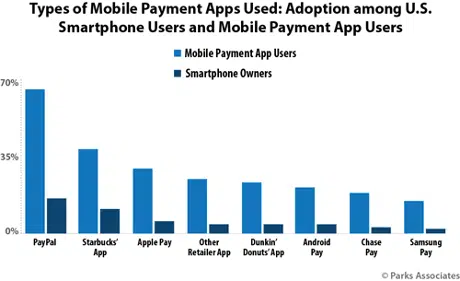
Nearly one in five US smartphone owners (18%) have now used a mobile payment app, research released by Parks Associates reveals, with PayPal proving to be the most popular among all US smartphone users with 12%, followed by retail-branded mobile apps (9%), Apple Pay (4%), Android Pay (3%) and Samsung Pay (2%).
While PayPal is the clear leader in terms of users across all US smartphone owners and mobile payment app users, merchants are requesting Apple Pay “much more” than they are requesting PayPal when it comes to in-store payments (67% vs 8%), the findings show.
When looking at the mobile payment app users specifically:
- Nearly 70% use PayPal
- About 40% use the Starbucks app
- More than 30% use Apple Pay
- About 25% use Android Pay
- More than 20% use Chase Pay
- About 18% use Samsung Pay
- While more than 67% of mobile payment app users are only using one mobile payment app.
Mobile payment app users report spending US$98 per month using PayPal, $75 per month with Apple Pay and $56 per month with Android Pay.
Among retailer-branded apps, Starbucks is the leader with 7% of US smartphone users, followed by Dunkin’ Donuts (3%).
‘Competitive disadvantage’
“While PayPal is the clear market share leader, more merchants are requesting information from Apple Pay than any other mobile payment solution,” says Chris Tweedt, research analyst at Parks Associates.
“Apple has added a Pay with Apple Pay button into its Safari browser and the company has signed up 21 of the top 100 online merchants, with others to come. Likewise, Google has launched an Android Pay function into its mobile Chrome browser. PayPal’s counter strategy is to leverage its large customer base and Venmo’s popularity to expand into in-store payments and earn revenue from transaction fees.”
“Merchants must be ready to accept mobile payments because those that wait will be at a competitive disadvantage,” Tweedt adds. “Users don’t spend much money with mobile apps today, but we expect to see a large increase — as much as 150% — in mobile payment users and transaction values over the next five years.”
Next: Visit the NFCW Expo to find new suppliers and solutions